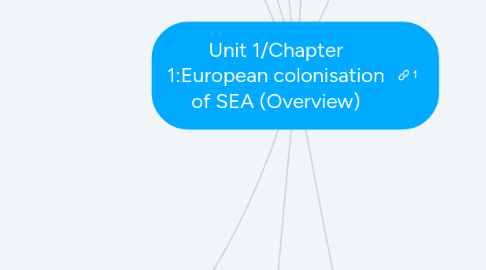
1. Implement European ideas of government and development.
1.1. Raden Ajeng Kartini, sought to advance the interests of especially women in Indonesia - established Western style schools (Javanese girls have education)
2. Loss of power for local rulers
3. Growth of Western-educated elites
3.1. Residents appointed to provide advice to rulers on most matters
3.1.1. E.g. Malay sultanate
3.1.1.1. Unfederated Malay States (1909-1930) [UFMS]
3.1.2. French - Tonkin , Annam (1883)
3.1.3. Dutch - Java
3.1.3.1. for junior/middle level workers for civil service and trading companies.
4. 1.2 How did SEAsians respond to colonisation?
4.1. Preoccupation with local issues
4.1.1. Fierce internal competition among local rulers for power --> sought help from Europeans in return provide some concessions or hand over some political power to Europeans.
4.1.1.1. Malaya - Raja Abdullah - throne in Perak
4.1.1.2. Sumatra - Dutch support in Padri War - offer Dutch control over Minangkabau
4.1.1.3. Vietnam - persecution of Catholics - French intervention
4.2. Resistance
4.2.1. Mostly unsuccessful because of Western superiority in weaponry. Europeans in turn gain more territories.
4.2.1.1. Perak - Local chief murder first British Resident - Perak War(1875-1876)
4.2.1.2. Aceh War (1873-1904) Local resistance to Dutch rule
4.3. Collaboration
4.3.1. Rulers retain ceremonial positions and accepted European authority in most of Malaya, Vietnam and Indonesia.
4.3.1.1. Malaya - Malay sultans accepted British advisors and Malay elites were co-opted into the civil service. Chinese merchants relied on British to maintain stability.
4.4. Modernisation
5. 1.3 Impact of colonial rule on SEA
5.1. Political
5.1.1. New boundaries
5.1.2. Transfer power from local rulers to Europeans
5.1.2.1. Direct rule
5.1.2.1.1. removed or marginalised existing kings or sultans.
5.1.2.1.2. Ruled through European colonial official (Governor)
5.1.3. Centralised administration
5.1.3.1. Colonial rulers exert rule over various territories through one central place of control. Structure is fixed.
5.2. Social
5.2.1. VS
5.2.1.1. Traditional system, many centres of power. Dependent on personal popularity and influence of rulers. Situation fluid.
5.2.2. Influx of migrants and immigrants
5.2.3. Creation of plural societies
5.2.3.1. Divide and rule
5.2.3.1.1. Majority came from China and India to work as coolies. Minority - Merchants, entrepreneurs, professionals or money lenders
5.2.3.2. Low- ranking positions, lost decision making power.
5.2.3.3. Different ethnic group remained separated, no integration
5.2.3.3.1. Segregated in different quarters of towns and cities.
5.2.4. Urbanisation
5.2.4.1. Indirect rule
5.2.4.1.1. producing surpluses and fulfilling global demand for raw materials and cash crops.
5.2.5. New Social classes
5.2.5.1. Federated Malay States (1896) [FMS]
5.3. Existing kings or sultans remains
5.4. Economic
5.4.1. Europeans migrated to SEA to work in colonial civil service/industries, plantations and trade
5.4.2. Subsistence - based to export-oriented economy
5.4.2.1. expansion of towns and creation of new cities
5.4.2.1.1. Kuala Lumpur - Tin mining village to major city. Capital of Selangor.
5.4.2.1.2. Rise of KL, Jakarta and Saigon
5.4.2.2. local entrepreneurs, landowners, moneylenders and educated elites
5.4.2.2.1. e.g. British Malay - wealthy Chinese (revenue farming - collecting taxes from farmers at higher rate than actual tax before passing to colonial office)
5.4.2.2.2. E.g. Vietnam - western educated indigenous Vietnamese employed in civil service
5.4.3. Creation of industries, plantations and small holdings.
5.4.3.1. Extractive industries
5.4.3.1.1. raw materials and fuel such as tin and oil.
5.4.3.1.2. Local way of life changed - work in factories
5.4.3.1.3. Wave of migrant workers.
5.4.3.2. Plantation estates
5.4.3.2.1. export crops such as teakwood from Burma, rubber from Malay and spices, tea, coffee and palm oil from Indonesia.
5.4.4. Smallholdings
5.4.4.1. mostly owned by Chinese, Indians or Malays.
5.4.4.2. grew crops near home
5.4.4.3. Entrepreneurial class which reaped profits from colonial trade.
5.4.5. New transport and communications infrastructure
5.4.6. Intro cash economy
5.4.6.1. modern roads, rail, telegraphs, wharves built to facilitate trade.
5.4.6.1.1. to connect mines, plantations to the coasts and sped up export
5.4.6.2. taxation system required that taxes be paid in cash
5.4.6.2.1. replaced barter trade.
5.4.6.2.2. Locals sell products for cash to pay tax
6. Land ownership
6.1. colonial governments practice of issuing land grants to companies and individuals to encourage cash crops planting (individual ownership)
6.1.1. vs
6.1.1.1. land managed by entire village
6.2. Smallholders borrowed money to farm
6.2.1. when fail/could not pay tax - land lost to money-lenders, became landless peasants
6.3. Landowners hired labourers to work
7. Undefined to clearly defined boundaries as a result from deals between colonial powers.
7.1. sometimes cut through impenetrable jungles, rivers or divided villages and ethnic communities.
8. 1.1 Reason for colonisation
8.1. Economic (Amplification)
8.1.1. Need to protect trade interests and trade routes. Sometimes local unrest can disrupt trade.
8.1.2. SEA rich in raw materials. Malaya - Tin, rubber, sugar. Vietnam - Coal, rice.
8.2. Political
8.2.1. Rivalry among European power.
8.2.1.1. After Franco-Prussian war, creation of Germany who was keen to grow its empire overseas - spark colonisation as they fear Germany would beat them to it and cut off raw materials and markets. (Trigger)
8.3. Social
8.3.1. White Man's Burden
8.3.1.1. SEA as backward and misrule, bring civilisation to improve lives of SEAsian
8.3.2. Local conditions
8.3.2.1. Colonisation gives easier control and more economic benefits. Though government not keen, but local officials would intervene in local affairs before reporting because of slow telecommunications.
8.4. Events(Root)
8.4.1. Industrial Revolution
8.4.1.1. Need for raw materials e.g. tin, rubber, coal (Fuel for machines) readily available in Southeast Asia. New markets to sell goods.
8.4.2. Opening of Suez Canal
8.4.2.1. Cut time taken to travel from Europe to SEA by half. Easier to travel for trading.
8.4.2.2. No longer need to go around cape of Good Hope.

